NISSAN TERRANO 2002 Service Repair Manual
Manufacturer: NISSAN, Model Year: 2002, Model line: TERRANO, Model: NISSAN TERRANO 2002Pages: 1767, PDF Size: 41.51 MB
Page 231 of 1767
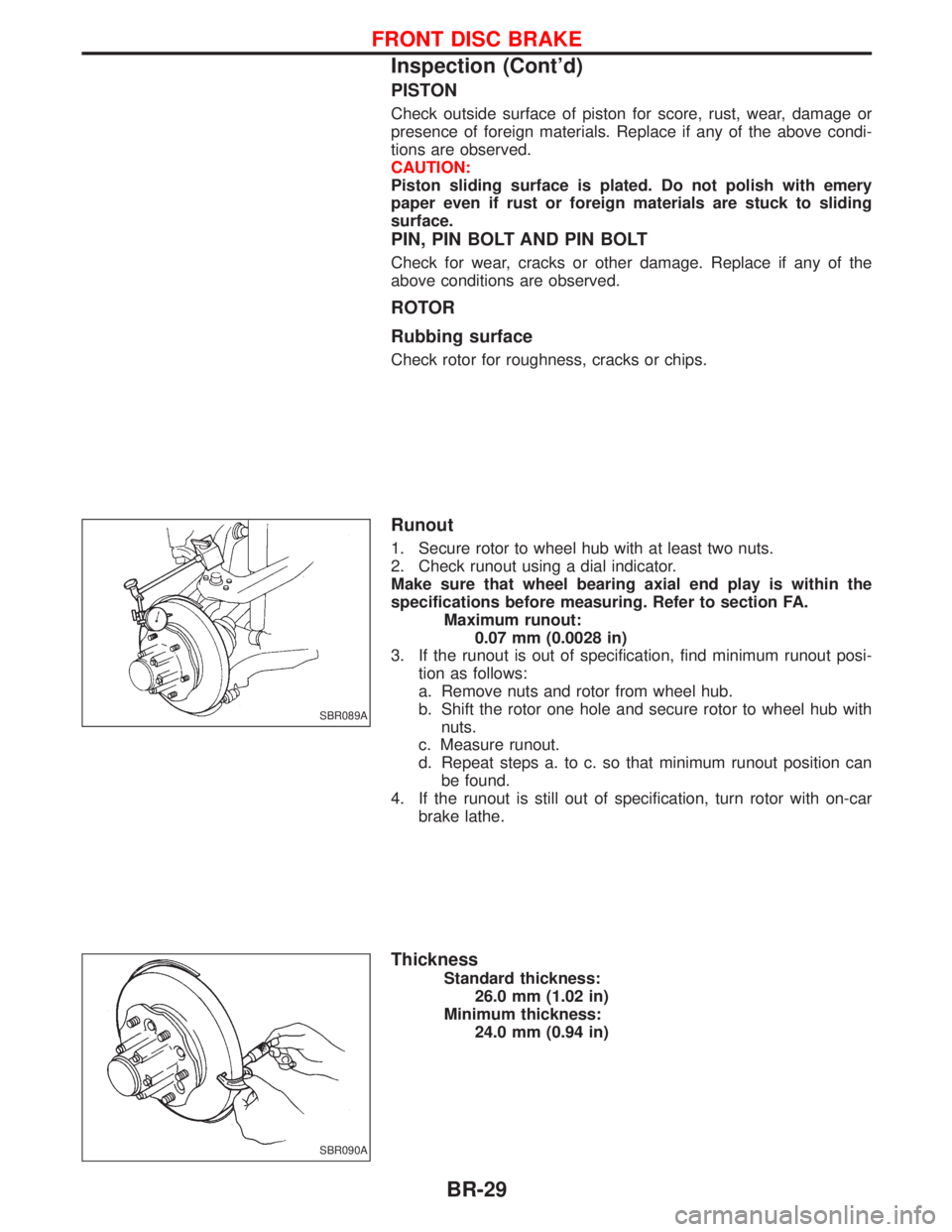
PISTON
Check outside surface of piston for score, rust, wear, damage or
presence of foreign materials. Replace if any of the above condi-
tions are observed.
CAUTION:
Piston sliding surface is plated. Do not polish with emery
paper even if rust or foreign materials are stuck to sliding
surface.
PIN, PIN BOLT AND PIN BOLT
Check for wear, cracks or other damage. Replace if any of the
above conditions are observed.
ROTOR
Rubbing surface
Check rotor for roughness, cracks or chips.
Runout
1. Secure rotor to wheel hub with at least two nuts.
2. Check runout using a dial indicator.
Make sure that wheel bearing axial end play is within the
specifications before measuring. Refer to section FA.
Maximum runout:
0.07 mm (0.0028 in)
3. If the runout is out of specification, find minimum runout posi-
tion as follows:
a. Remove nuts and rotor from wheel hub.
b. Shift the rotor one hole and secure rotor to wheel hub with
nuts.
c. Measure runout.
d. Repeat steps a. to c. so that minimum runout position can
be found.
4. If the runout is still out of specification, turn rotor with on-car
brake lathe.
Thickness
Standard thickness:
26.0 mm (1.02 in)
Minimum thickness:
24.0 mm (0.94 in)
SBR089A
SBR090A
FRONT DISC BRAKE
Inspection (Cont'd)
BR-29
Page 232 of 1767
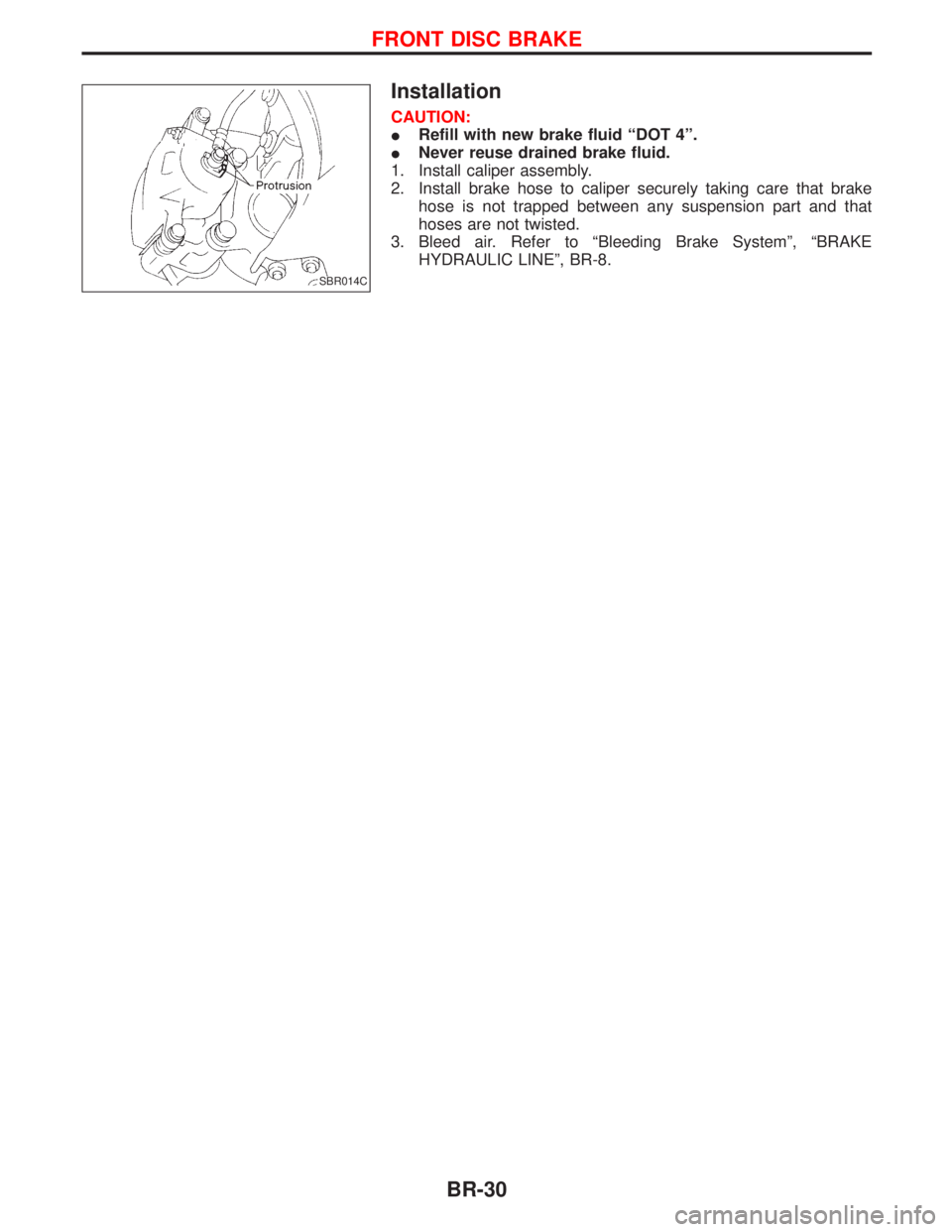
Installation
CAUTION:
IRefill with new brake fluid ªDOT 4º.
INever reuse drained brake fluid.
1. Install caliper assembly.
2. Install brake hose to caliper securely taking care that brake
hose is not trapped between any suspension part and that
hoses are not twisted.
3. Bleed air. Refer to ªBleeding Brake Systemº, ªBRAKE
HYDRAULIC LINEº, BR-8.
SBR014C
FRONT DISC BRAKE
BR-30
Page 233 of 1767
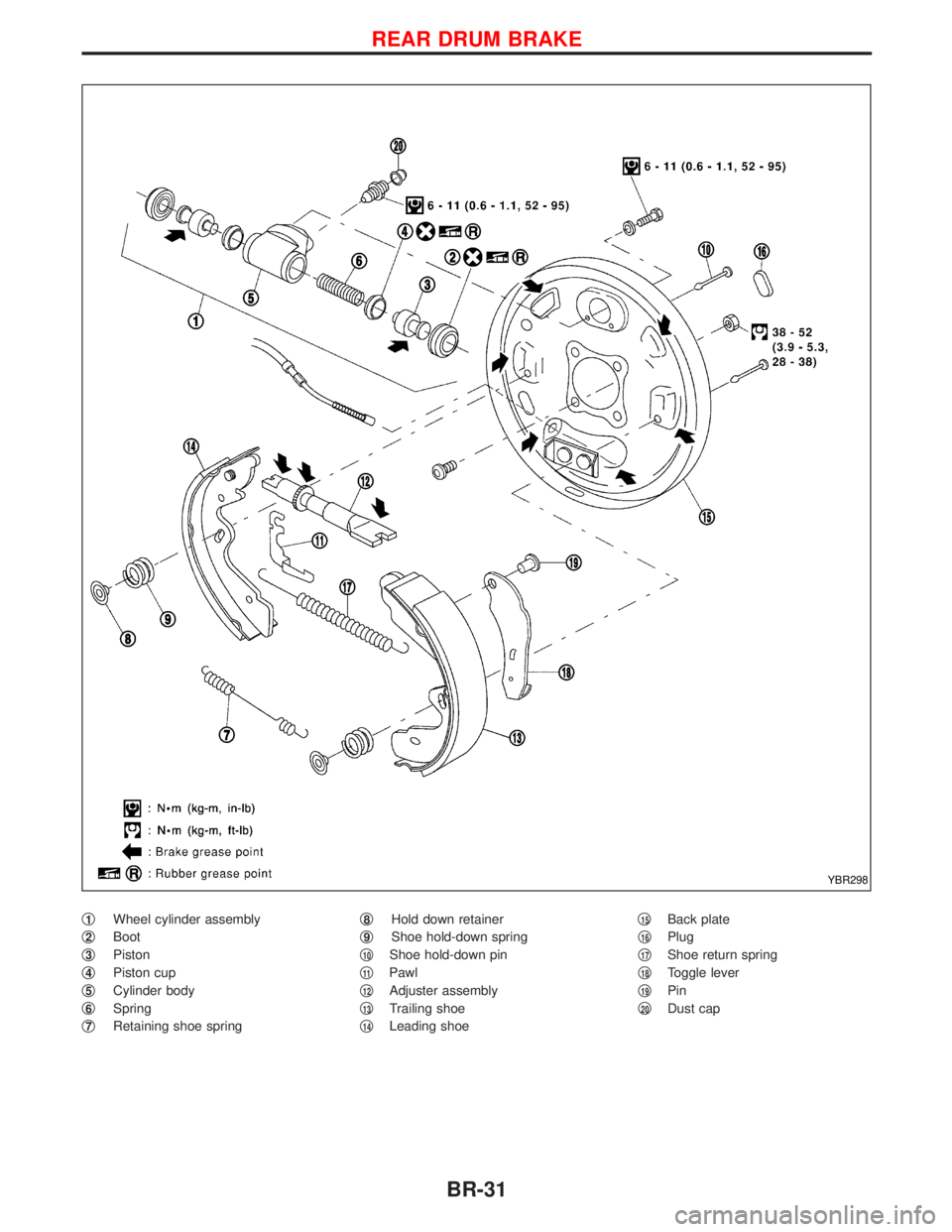
q1Wheel cylinder assembly
q
2Boot
q
3Piston
q
4Piston cup
q
5Cylinder body
q
6Spring
q
7Retaining shoe springq
8Hold down retainer
q
9Shoe hold-down spring
q
10Shoe hold-down pin
q
11Pawl
q
12Adjuster assembly
q
13Trailing shoe
q
14Leading shoeq
15Back plate
q
16Plug
q
17Shoe return spring
q
18Toggle lever
q
19Pin
q
20Dust cap
YBR298
REAR DRUM BRAKE
BR-31
Page 234 of 1767
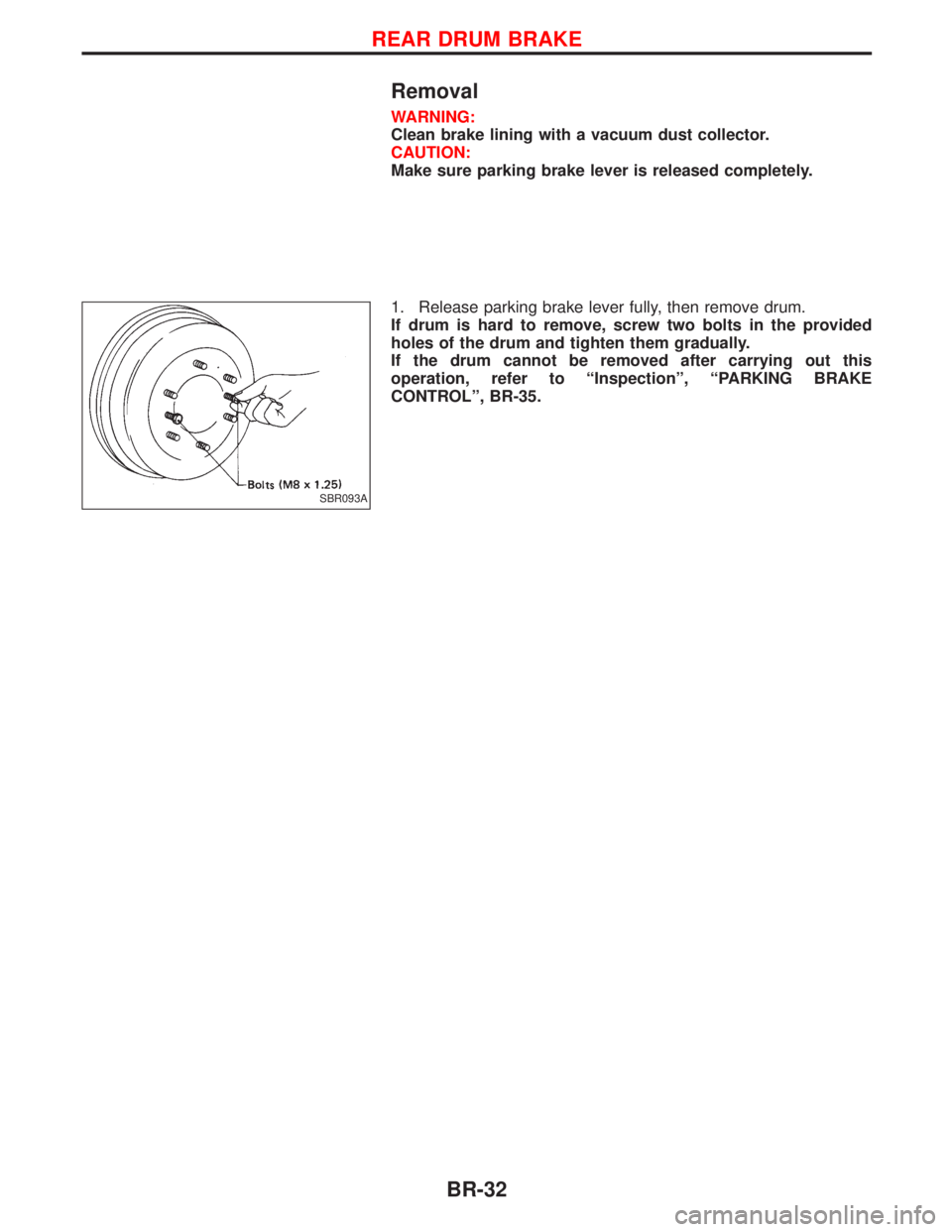
Removal
WARNING:
Clean brake lining with a vacuum dust collector.
CAUTION:
Make sure parking brake lever is released completely.
1. Release parking brake lever fully, then remove drum.
If drum is hard to remove, screw two bolts in the provided
holes of the drum and tighten them gradually.
If the drum cannot be removed after carrying out this
operation, refer to ªInspectionº, ªPARKING BRAKE
CONTROLº, BR-35.
SBR093A
REAR DRUM BRAKE
BR-32
Page 235 of 1767
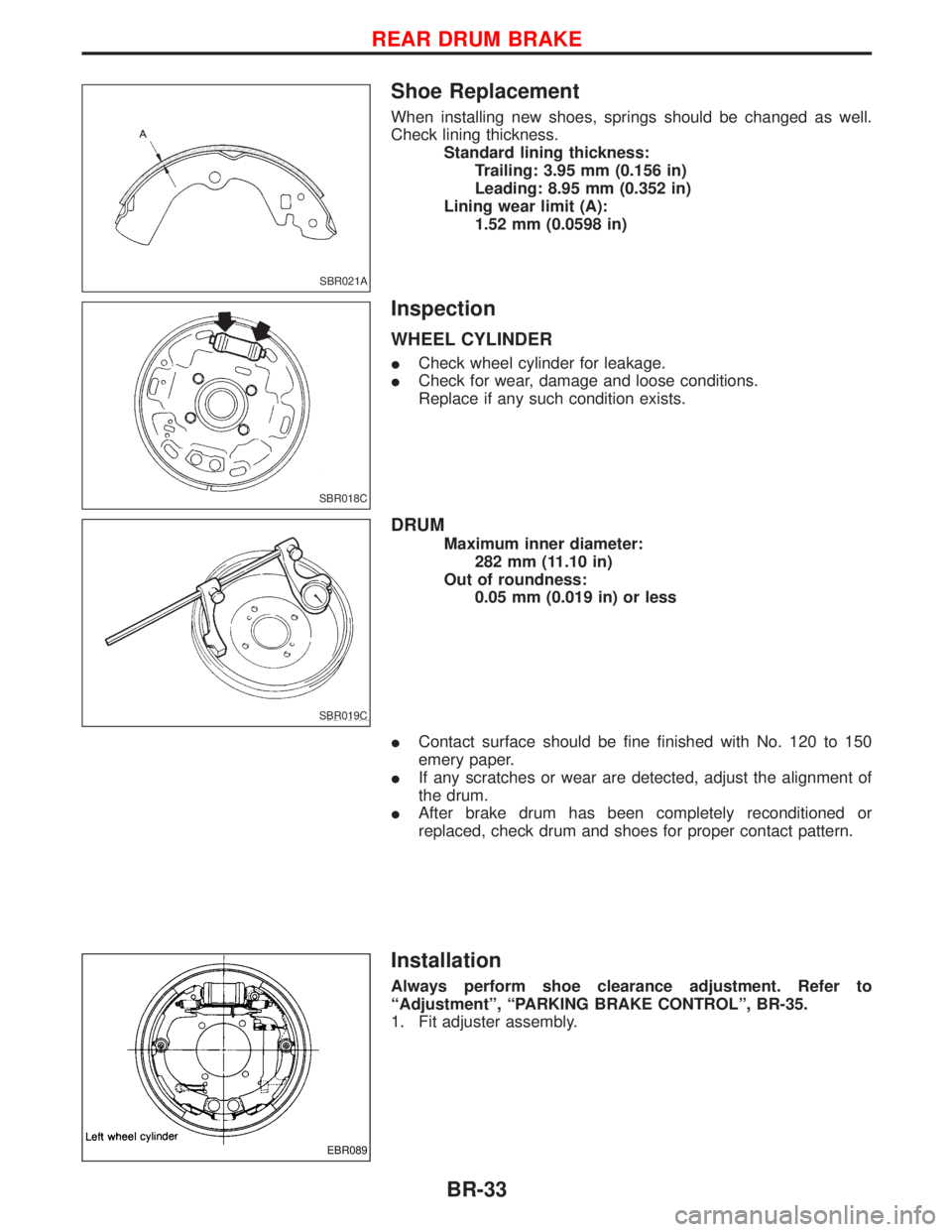
Shoe Replacement
When installing new shoes, springs should be changed as well.
Check lining thickness.
Standard lining thickness:
Trailing: 3.95 mm (0.156 in)
Leading: 8.95 mm (0.352 in)
Lining wear limit (A):
1.52 mm (0.0598 in)
Inspection
WHEEL CYLINDER
ICheck wheel cylinder for leakage.
ICheck for wear, damage and loose conditions.
Replace if any such condition exists.
DRUM
Maximum inner diameter:
282 mm (11.10 in)
Out of roundness:
0.05 mm (0.019 in) or less
IContact surface should be fine finished with No. 120 to 150
emery paper.
IIf any scratches or wear are detected, adjust the alignment of
the drum.
IAfter brake drum has been completely reconditioned or
replaced, check drum and shoes for proper contact pattern.
Installation
Always perform shoe clearance adjustment. Refer to
ªAdjustmentº, ªPARKING BRAKE CONTROLº, BR-35.
1. Fit adjuster assembly.
SBR021A
SBR018C
SBR019C
EBR089
REAR DRUM BRAKE
BR-33
Page 236 of 1767
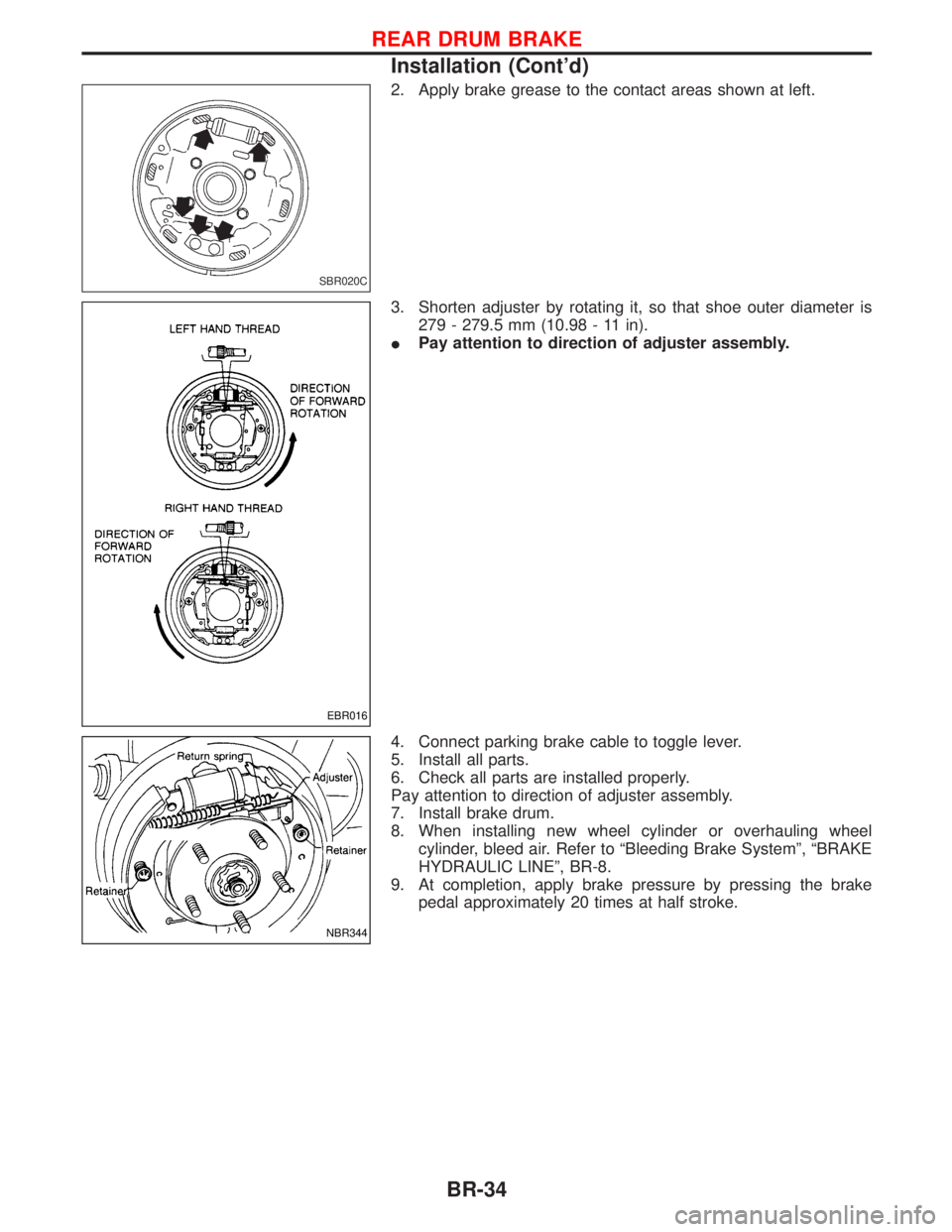
2. Apply brake grease to the contact areas shown at left.
3. Shorten adjuster by rotating it, so that shoe outer diameter is
279 - 279.5 mm (10.98 - 11 in).
IPay attention to direction of adjuster assembly.
4. Connect parking brake cable to toggle lever.
5. Install all parts.
6. Check all parts are installed properly.
Pay attention to direction of adjuster assembly.
7. Install brake drum.
8. When installing new wheel cylinder or overhauling wheel
cylinder, bleed air. Refer to ªBleeding Brake Systemº, ªBRAKE
HYDRAULIC LINEº, BR-8.
9. At completion, apply brake pressure by pressing the brake
pedal approximately 20 times at half stroke.
SBR020C
EBR016
NBR344
REAR DRUM BRAKE
Installation (Cont'd)
BR-34
Page 237 of 1767
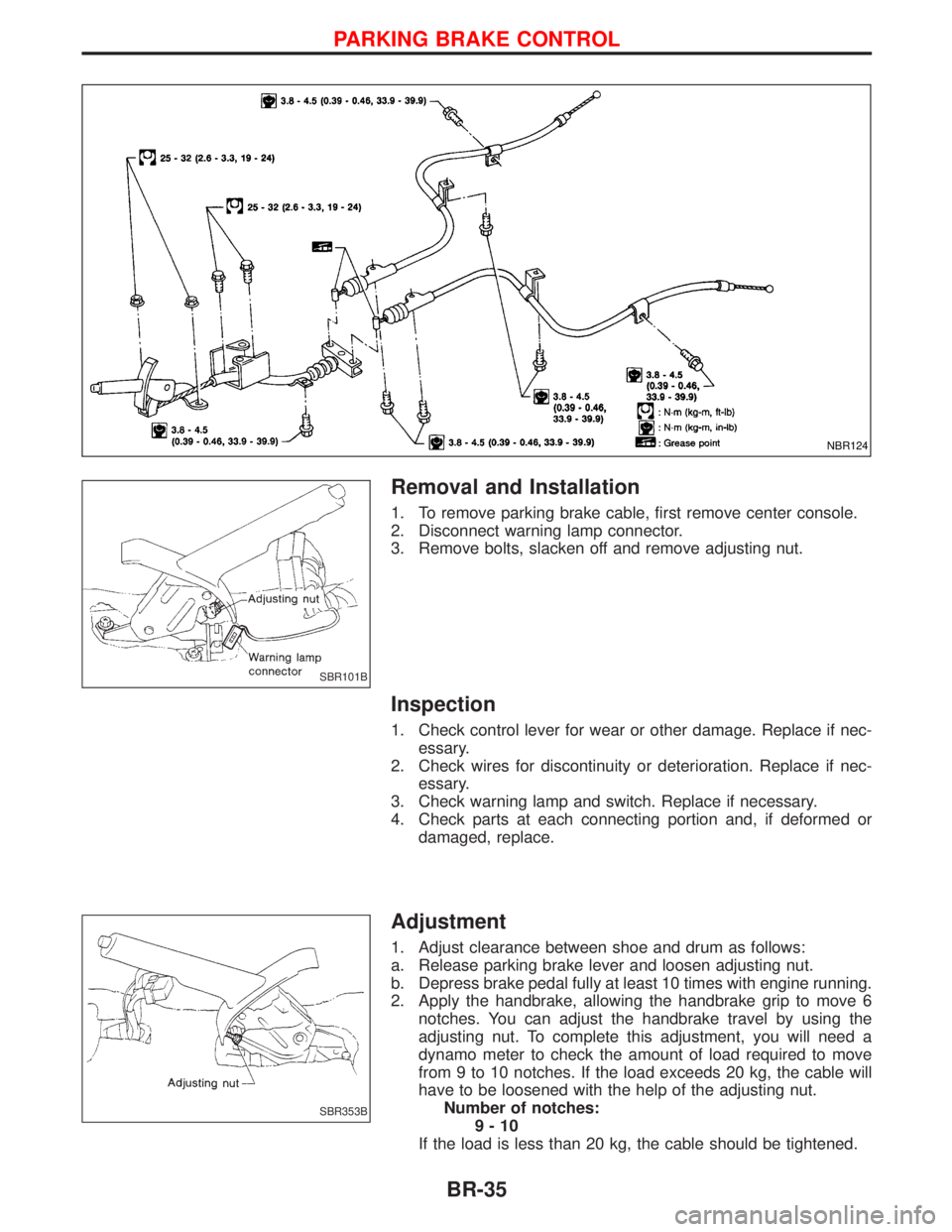
Removal and Installation
1. To remove parking brake cable, first remove center console.
2. Disconnect warning lamp connector.
3. Remove bolts, slacken off and remove adjusting nut.
Inspection
1. Check control lever for wear or other damage. Replace if nec-
essary.
2. Check wires for discontinuity or deterioration. Replace if nec-
essary.
3. Check warning lamp and switch. Replace if necessary.
4. Check parts at each connecting portion and, if deformed or
damaged, replace.
Adjustment
1. Adjust clearance between shoe and drum as follows:
a. Release parking brake lever and loosen adjusting nut.
b. Depress brake pedal fully at least 10 times with engine running.
2. Apply the handbrake, allowing the handbrake grip to move 6
notches. You can adjust the handbrake travel by using the
adjusting nut. To complete this adjustment, you will need a
dynamo meter to check the amount of load required to move
from 9 to 10 notches. If the load exceeds 20 kg, the cable will
have to be loosened with the help of the adjusting nut.
Number of notches:
9-10
If the load is less than 20 kg, the cable should be tightened.
NBR124
SBR101B
SBR353B
PARKING BRAKE CONTROL
BR-35
Page 238 of 1767
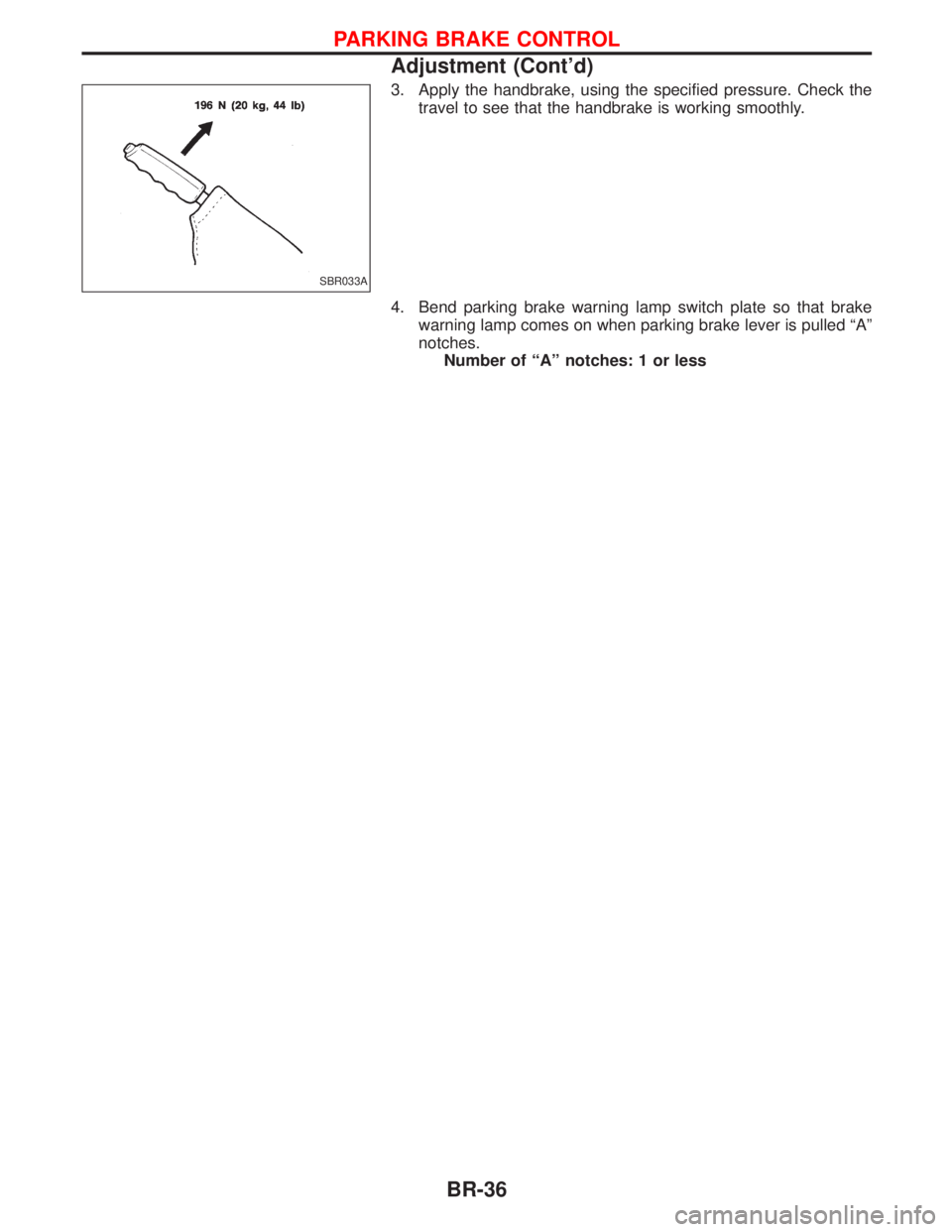
3. Apply the handbrake, using the specified pressure. Check the
travel to see that the handbrake is working smoothly.
4. Bend parking brake warning lamp switch plate so that brake
warning lamp comes on when parking brake lever is pulled ªAº
notches.
Number of ªAº notches: 1 or less
SBR033A
PARKING BRAKE CONTROL
Adjustment (Cont'd)
BR-36
Page 239 of 1767
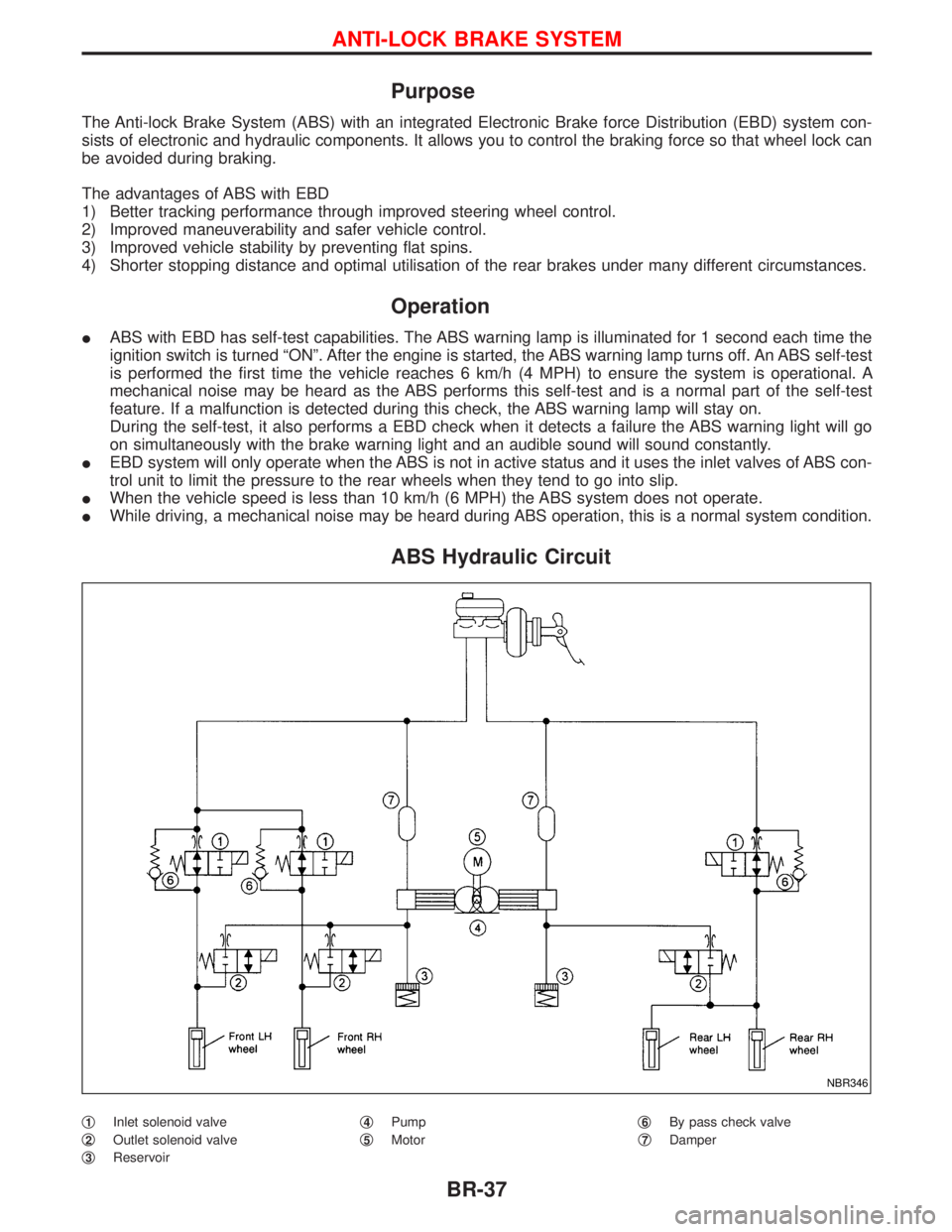
Purpose
The Anti-lock Brake System (ABS) with an integrated Electronic Brake force Distribution (EBD) system con-
sists of electronic and hydraulic components. It allows you to control the braking force so that wheel lock can
be avoided during braking.
The advantages of ABS with EBD
1) Better tracking performance through improved steering wheel control.
2) Improved maneuverability and safer vehicle control.
3) Improved vehicle stability by preventing flat spins.
4) Shorter stopping distance and optimal utilisation of the rear brakes under many different circumstances.
Operation
IABS with EBD has self-test capabilities. The ABS warning lamp is illuminated for 1 second each time the
ignition switch is turned ªONº. After the engine is started, the ABS warning lamp turns off. An ABS self-test
is performed the first time the vehicle reaches 6 km/h (4 MPH) to ensure the system is operational. A
mechanical noise may be heard as the ABS performs this self-test and is a normal part of the self-test
feature. If a malfunction is detected during this check, the ABS warning lamp will stay on.
During the self-test, it also performs a EBD check when it detects a failure the ABS warning light will go
on simultaneously with the brake warning light and an audible sound will sound constantly.
IEBD system will only operate when the ABS is not in active status and it uses the inlet valves of ABS con-
trol unit to limit the pressure to the rear wheels when they tend to go into slip.
IWhen the vehicle speed is less than 10 km/h (6 MPH) the ABS system does not operate.
IWhile driving, a mechanical noise may be heard during ABS operation, this is a normal system condition.
ABS Hydraulic Circuit
q1Inlet solenoid valve
q
2Outlet solenoid valve
q
3Reservoirq
4Pump
q
5Motorq
6By pass check valve
q
7Damper
NBR346
ANTI-LOCK BRAKE SYSTEM
BR-37
Page 240 of 1767
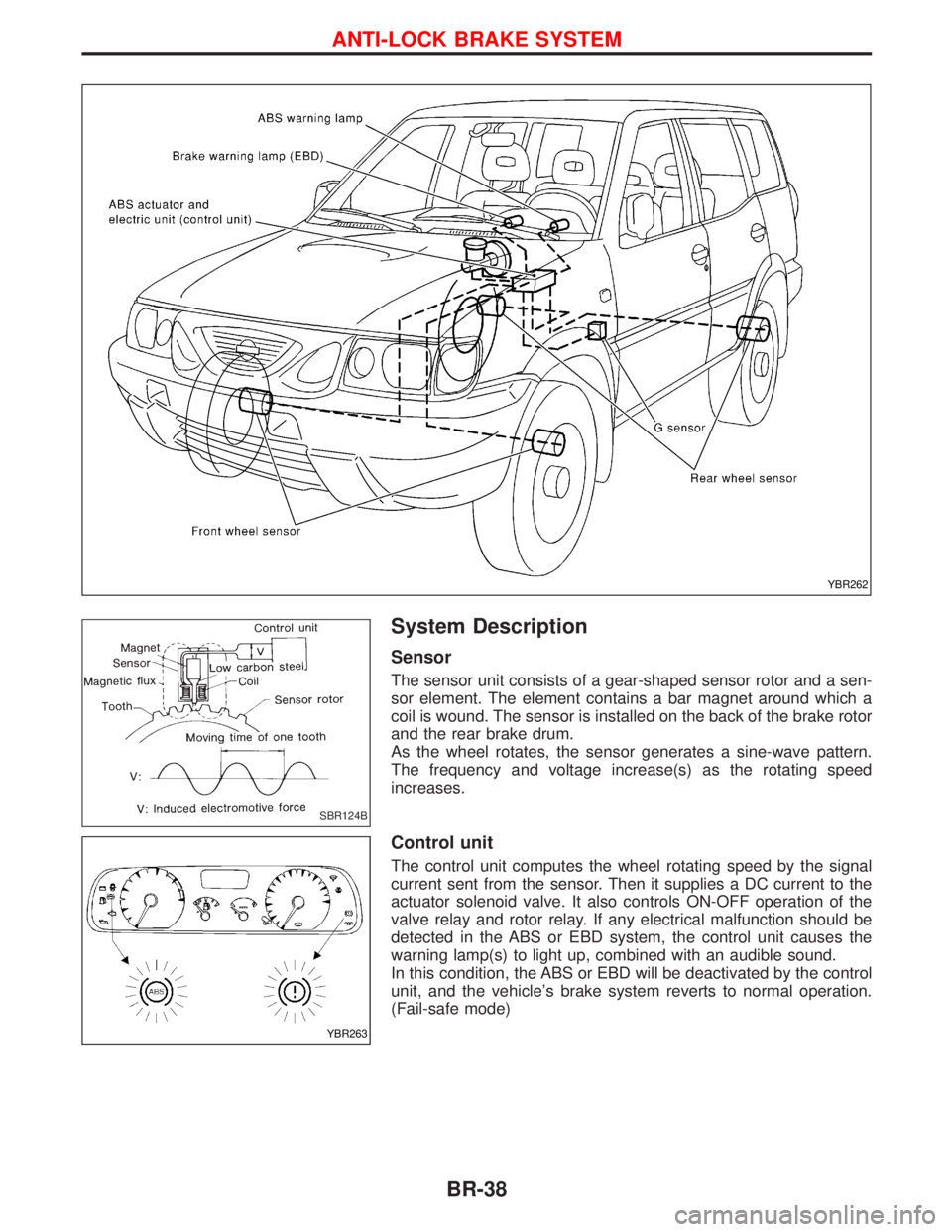
System Description
Sensor
The sensor unit consists of a gear-shaped sensor rotor and a sen-
sor element. The element contains a bar magnet around which a
coil is wound. The sensor is installed on the back of the brake rotor
and the rear brake drum.
As the wheel rotates, the sensor generates a sine-wave pattern.
The frequency and voltage increase(s) as the rotating speed
increases.
Control unit
The control unit computes the wheel rotating speed by the signal
current sent from the sensor. Then it supplies a DC current to the
actuator solenoid valve. It also controls ON-OFF operation of the
valve relay and rotor relay. If any electrical malfunction should be
detected in the ABS or EBD system, the control unit causes the
warning lamp(s) to light up, combined with an audible sound.
In this condition, the ABS or EBD will be deactivated by the control
unit, and the vehicle's brake system reverts to normal operation.
(Fail-safe mode)
YBR262
SBR124B
YBR263
ANTI-LOCK BRAKE SYSTEM
BR-38